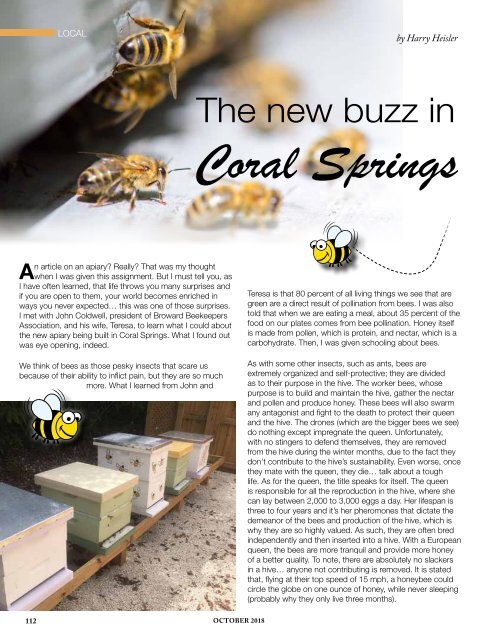You also want an ePaper? Increase the reach of your titles
YUMPU automatically turns print PDFs into web optimized ePapers that Google loves.
LOCAL<br />
by Harry Heisler<br />
The new buzz in<br />
Coral Springs<br />
An article on an apiary? Really? That was my thought<br />
when I was given this assignment. But I must tell you, as<br />
I have often learned, that life throws you many surprises and<br />
if you are open to them, your world becomes enriched in<br />
ways you never expected… this was one of those surprises.<br />
I met with John Coldwell, president of Broward Beekeepers<br />
Association, and his wife, Teresa, to learn what I could about<br />
the new apiary being built in Coral Springs. What I found out<br />
was eye opening, indeed.<br />
We think of bees as those pesky insects that scare us<br />
because of their ability to inflict pain, but they are so much<br />
more. What I learned from John and<br />
Teresa is that 80 percent of all living things we see that are<br />
green are a direct result of pollination from bees. I was also<br />
told that when we are eating a meal, about 35 percent of the<br />
food on our plates comes from bee pollination. Honey itself<br />
is made from pollen, which is protein, and nectar, which is a<br />
carbohydrate. Then, I was given schooling about bees.<br />
As with some other insects, such as ants, bees are<br />
extremely organized and self-protective; they are divided<br />
as to their purpose in the hive. The worker bees, whose<br />
purpose is to build and maintain the hive, gather the nectar<br />
and pollen and produce honey. These bees will also swarm<br />
any antagonist and fight to the death to protect their queen<br />
and the hive. The drones (which are the bigger bees we see)<br />
do nothing except impregnate the queen. Unfortunately,<br />
with no stingers to defend themselves, they are removed<br />
from the hive during the winter months, due to the fact they<br />
don’t contribute to the hive’s sustainability. Even worse, once<br />
they mate with the queen, they die… talk about a tough<br />
life. As for the queen, the title speaks for itself. The queen<br />
is responsible for all the reproduction in the hive, where she<br />
can lay between 2,000 to 3,000 eggs a day. Her lifespan is<br />
three to four years and it’s her pheromones that dictate the<br />
demeanor of the bees and production of the hive, which is<br />
why they are so highly valued. As such, they are often bred<br />
independently and then inserted into a hive. With a European<br />
queen, the bees are more tranquil and provide more honey<br />
of a better quality. To note, there are absolutely no slackers<br />
in a hive… anyone not contributing is removed. It is stated<br />
that, flying at their top speed of 15 mph, a honeybee could<br />
circle the globe on one ounce of honey, while never sleeping<br />
(probably why they only live three months).<br />
112<br />
OCTOBER <strong>2018</strong>





